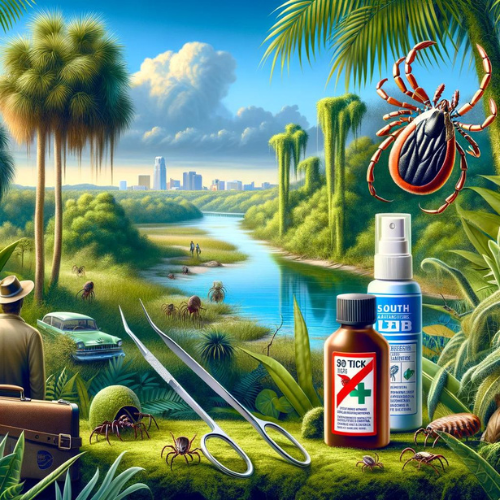
27 Feb Safe Tick Removal Techniques
Combating Ticks in South Florida
Ticks are tiny creatures that can cause significant health issues. In South Florida, where the climate is ideal for these pests, it’s especially important for residents to be aware of the risks and know how to deal with them effectively.
Ticks are small arachnids, part of the same family as spiders and mites. They are parasites, relying on the blood of their hosts to survive and reproduce. Ticks have four life stages: egg, larva, nymph, and adult. To move from one stage to the next, they need to feed on blood, making them a concern for humans and animals alike.
In South Florida, ticks are most active during the warmer months, but they can be a year-round problem due to the mild climate. They are commonly found in wooded areas, tall grasses, and bushes, waiting for a potential host to pass by. When a host brushes against the spot where a tick is waiting, it quickly latches on and begins its meal.
Ticks are not just a nuisance; they are also carriers of diseases. Lyme disease, Rocky Mountain spotted fever, and ehrlichiosis are just a few of the illnesses that can be transmitted by ticks. The risk of contracting these diseases increases the longer a tick is attached to the skin, making prompt removal crucial.
Tick-Proofing Your Outdoor Adventures
Preventing tick bites is essential to avoid the diseases they carry. Here are some strategies to reduce your risk:
Protective Clothing: Wear long-sleeved shirts, long pants, and closed-toe shoes when you’re in areas where ticks are likely to be found. Tucking your pants into your socks can provide an extra barrier.
Tick Repellents: Use repellents that contain DEET, picaridin, or IR3535 on exposed skin. Treat clothing with products containing 0.5% permethrin for added protection.
Stay on Trails: When hiking or walking in nature, stick to the center of trails to minimize contact with vegetation where ticks may be waiting.
Regular Checks: After spending time outdoors, thoroughly check your body, clothing, and gear for ticks. Don’t forget to inspect your pets, as they can bring ticks into your home.
Tick Extraction Techniques
If you find a tick attached to your skin, it’s important to remove it properly to reduce the risk of disease transmission:
Use the Right Tool: Fine-tipped tweezers are the best tool for removing ticks. They allow you to grasp the tick without crushing it.
Remove the Tick: Gently pull the tick straight out with steady, even pressure. Avoid twisting or jerking, as this can cause the mouth-parts to break off and remain in the skin.
Clean the Area: After removing the tick, clean the bite area and your hands with rubbing alcohol, an iodine scrub, or soap and water.
Dispose of the Tick: Place the tick in a sealed bag or container, or submerge it in alcohol. You can also wrap it tightly in tape or flush it down the toilet. Do not crush the tick with your fingers.
Monitoring After Tick Removal
Once the tick is removed, monitor the bite site for signs of infection or disease:
Watch for Symptoms: Be alert for any signs of illness, such as a rash, fever, or flu-like symptoms, in the weeks following a tick bite. If you experience any of these symptoms, consult a healthcare professional.
Save the Tick: Keeping the tick in a sealed container can be helpful for medical diagnosis if symptoms develop.
Seek Medical Attention: If you develop symptoms or if the tick was attached for a long time, it’s important to seek medical advice. Early treatment can prevent serious complications from tick-borne diseases.
Reducing Tick Risks at Home
Creating a tick-free zone around your home can further reduce your risk of tick bites:
Landscape Maintenance: Keep your lawn mowed and remove tall weeds and brush. This reduces the habitat for ticks and their hosts.
Barrier Creation: Create a barrier of wood chips or gravel between your lawn and wooded areas to restrict tick migration into your yard.
Debris Removal: Clear away leaf litter, tall grasses, and fallen branches, which can provide hiding spots for ticks.
Pest Control: Consider using tick control products in your yard, such as acaricides (tick pesticides). You can also hire a professional pest control service to treat your property.
Conclusion
In South Florida, ticks are a year-round concern, and proactive measures are essential for minimizing the risks they pose. The importance of regular checks, protective clothing, and tick repellents cannot be overstated, as these are the first lines of defense against tick bites. By staying vigilant and taking preventive steps, residents can reduce their exposure to ticks and the diseases they carry.
Proper removal and monitoring after a tick bite are crucial for preventing complications. The use of fine-tipped tweezers and careful extraction techniques can minimize the risk of disease transmission. Being observant for symptoms following a tick bite is vital, as early detection and treatment can prevent serious health issues.
Creating a tick-free environment at home is an important aspect of tick control. Regular maintenance of lawns and gardens, along with the use of barriers and pest control products, can significantly reduce the presence of ticks in residential areas. By implementing these strategies, South Florida residents can enjoy the outdoors with greater peace of mind, knowing they are taking proactive steps to protect themselves and their loved ones from tick-borne diseases.


No Comments